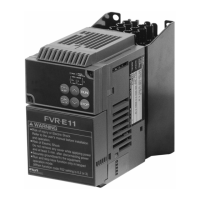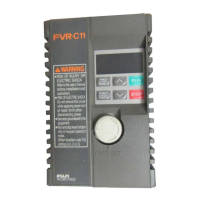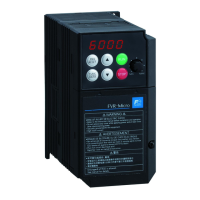2-4
2-3-2 Connection of Main Circuit and Grounding Terminal
Table2-3-1 Connection of Main Circuit and Grounding Terminal
Symbol Name of terminal Description
L1/R,L2/S,L3/T
Main circuit power
input
Connects a 3-phase power supply.
L1/L,L2/N
Main circuit power
input
Connects a 1-phase power supply.
U,V,W
Inverter output Connects a 3-phase induction motor.
P1,P(+)
For DC reactor Connects an optional DC reactor.
P(+),DB
For external braking
resistor
Connects an optional external braking resistor.
P(+),N(-)
DC link circuit terminal Connected to DC link circuit.
G
grounding Grounding terminal of the inverter chassis (housing).
Connect to the protective ground.
(1) Main circuit power input terminal (L1/R, L2/S, L3/T,L1/L,L2/N)
a. Connect the main circuit power input terminals to the power supply through a circuit breaker
for circuit (wiring) protection or an earth leakage breaker. There is not need to match the
phase sequence.
b. It is recommended to connect a magnetic contactor to disconnect the inverter from the power
supply to prevent a failure or accident from becoming serious upon activation of the
protective function of the inverter.
c. Do not turn the main circuit power supply on or off to start or stop the inverter. Instead, use
control circuit terminals FWD and REV or the RUN and STOP keys on the keypad panel. If it
is unavoidable to turn the main circuit power supply on or off to start or stop the inverter, limit
the frequency to once an hour or fewer.
d. Do not connect to a single-phase power supply for 3-phase input inverter.
(2) Inverter output terminals (U, V, W)
a. Connect these terminals to a 3-phase motor with the correct phase sequence. If the direction
of rotation does not match the operation direction, change arbitrary two cables among the U,
V and W phases.
b. Do not connect a phase advance capacitor or surge absorber to the inverter output.
c. If the wiring length between the inverter and the motor is extremely long, the stray capacity
between cables causes a high frequency current, possibly tripping the inverter due to an
overcurrent, increasing the leakage current, or deteriorating the current detection accuracy to
cause deterioration of the performance or other phenomena. To prevent such trouble, limit
the wiring length of the motor to 50 m for 4.0 kW or a smaller output or to 100 m for a larger
output.
Note: When a thermal relay is installed in the path between the inverter and the motor, or especially
in the case of a 400V system, the thermal relay may malfunction even with a wiring length
shorter than 50 m. In such a case, add an OFL filter or lower the Motor sound adjustment
(carrier frequency) of the inverter. ... Function code F26 Motor sound adjustment.

